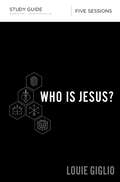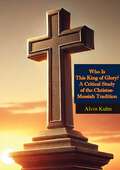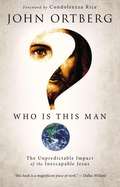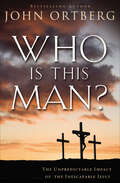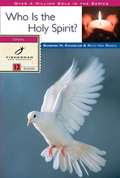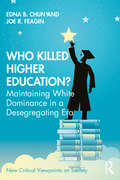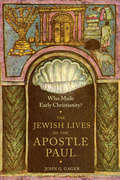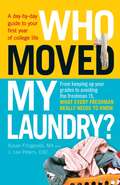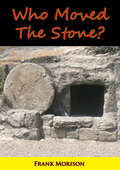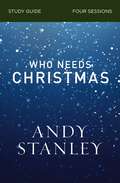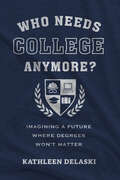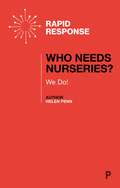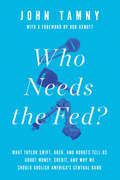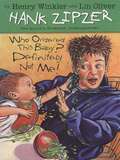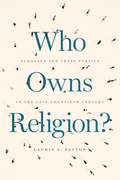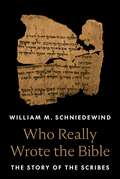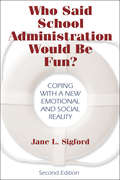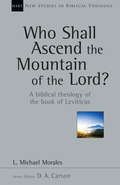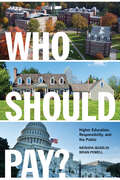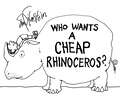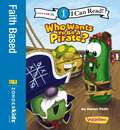- Table View
- List View
Who Is Jesus? Bible Study Guide
by Louie GiglioThe question has been asked and debated for generations. Some call him Lord. Some say he was a good man, a prophet, or a teacher. Still others call him a lunatic or liar. History, culture, and Scripture agree that all of life centers on your answer to this one question: Who Is Jesus?In this five-week video Bible study (DVD/digital video sold separately), Pastor Louie Giglio invites us to meet God in both our intellect and our hearts by uncovering what history and Scripture have to say about Jesus. Throughout the study, you'll witness how Jesus appeared and shaped the landscape of history, just as he shapes the landscape of our lives for eternity.For those just beginning to ask questions about him and those who have known him for a long time, the Who Is Jesus? Bible Study is a journey toward discovering the truth about history's most monumental figure and humanity's opportunity to know him personally.Sessions include:Good or God?Friend or Foe?King or Pawn?A Way or the Way?The Lion or the Lamb?Designed for use with the Who Is Jesus? Video Study (9780310094579) sold separately.
Who Is This King of Glory? A Critical Study of the Christos-Messiah Tradition: A Critical Study Of The Christos-messiah Tradition
by Alvin KuhnAlvin Kuhn’s "Who Is This King of Glory? A Critical Study of the Christos-Messiah Tradition" is a thought-provoking and scholarly examination of the origins and evolution of the Christos-Messiah concept. Kuhn, a distinguished philosopher and historian of religion, delves deeply into ancient texts, religious traditions, and historical contexts to unravel the complex and often misunderstood identity of the Messiah.Kuhn's book offers a comprehensive analysis of the Christos-Messiah tradition, tracing its roots back to pre-Christian and pagan mythologies. He explores how ancient civilizations, including the Egyptians, Greeks, and Persians, influenced the development of the messianic figure that would later become central to Christian theology. Through meticulous research and critical insight, Kuhn sheds light on the syncretic nature of religious beliefs and the ways in which early Christian thinkers adopted and adapted existing myths and symbols."Who Is This King of Glory?" challenges conventional understandings of the Messiah by presenting a broader historical and cultural perspective. Kuhn examines the symbolic and allegorical meanings behind the Christ figure, emphasizing the spiritual and philosophical messages that transcend literal interpretations. His work encourages readers to consider the Christos not merely as a historical figure but as a universal archetype representing the divine potential within every human being.Kuhn's writing is both accessible and erudite, making complex ideas understandable for a wide audience. His critical approach invites readers to question traditional narratives and to explore the deeper spiritual truths that underpin religious traditions. The book is richly annotated with references to ancient texts, providing a valuable resource for further study.This compelling study not only enhances our understanding of religious history but also inspires a deeper appreciation for the timeless quest for spiritual enlightenment and the universal themes that connect humanity across cultures and epochs.
Who Is This Man?: The Unpredictable Impact of the Inescapable Jesus
by John OrtbergJohn Ortberg has written a powerful testament to the impact that Jesus has had on human history, the human condition, and our understanding of the obligations of one human being to another. John demonstrates that nothing in our existence has been quite the same since that fateful Sunday so long ago. The real power of this book rests in the paradox of our faith: that to follow Jesus is not a pathway to an easy life but a call to do hard things if we are to live in the image of our Lord. (From the book jacket.)
Who Is This Man?: The Unpredictable Impact of the Inescapable Jesus
by John OrtbergThe day after Jesus' death, whatever small mark he made on the world seemed destined to disappear. Instead, his impact on human history has been unparalleled, leading believers and nonbelievers alike to ask, Who Is This Man?In Who Is This Man, bestselling author John Ortberg explores the paradox of Jesus, history's most familiar figure while simultaneously the man no one knows. Who Is This Man traces Jesus' incredible life and legacy from his days on Earth to the present moment, showing us:How his vision of life continues to haunt and challenge humanityThe ways his influence has inspired movements in art, science, government, medicine, and educationHow his lessons about dignity, compassion, forgiveness, and hope continue to influence humanityJoin John Ortberg as he shares how Jesus' influence has swept over history and how his vision of life continues to impact us today.Praise for Who Is This Man?:"Sometimes in the clutter and noise of 'religion,' we lose sight of who Jesus is. Once again, John Ortberg helps us do what he does best: he helps us see God as he really is and connect with him amid all the noise. This book is a gift."--Dr. Henry Cloud, psychologist, coauthor of the bestselling Boundaries books"We live in a period where the divide between the secular and the sacred has never been greater. Who Is This Man? bridges this gap by sharing in his inimitable and entertaining style the undeniable and profound impact of Jesus Christ on our world. His impact, over two thousand years later, is more profound on the day-to-day lives of people--believers or not--than the impact of any other person at any point in history. John shows how Christ came to teach us how to live and in the process changed the world forever and for good."--Ron Johnson, CEO, J. C. Penney
Who Is the Holy Spirit? (Fisherman Bible Studyguide Series)
by Ruth E. Van Reken Barbara H. KnucklesWho is the Holy Spirit? God the Father is revealed in the Bible through his creation, his acts in history, and through metaphors and prophecies. Jesus Christ, the Son of God, is described in the New Testament gospels as a historical person who was seen, heard, and touched by his disciples. But God the Holy Spirit, the third person of the Trinity, is far more mysterious and elusive. This study guide offers biblical insights to help you come to a deeper understanding of the Holy Spirit as you discover how he works in our lives. You'll learn the unique role he plays in enabling us to live as children of God, in power and wisdom and unity, equipped for every good work. 12 SESSIONS FOR INDIVIDUALS OR GROUPS. Fisherman Bible Study guides include: * Penetrating questions that generate discussion * Flexible format for group or individual needs * Helpful leader's notes * Emphasis on daily application of Bible truth.
Who Killed Higher Education?: Maintaining White Dominance in a Desegregating Era
by Joe R. Feagin Edna B. ChunWho Killed Higher Education?: Maintaining White Dominance in a Desegregating Era offers a probing and unvarnished look at the causes of the substantial state defunding of public higher education over the last six decades. With the pandemic and cuts to social services, these challenges have only deepened, especially creating real dilemmas for first-generation, minoritized students seeking to complete a college education. Through extensive analysis of trends in public higher education funding, the book documents and lays bare the ways in which elite, neoliberal decision-makers launched a multi-pronged and attack on public higher education. It highlights the confluence of the enrollment of an increasingly diverse cohort of students in college with the efforts of conservative white legislatures to diminish funding support for public higher education. Who Killed Higher Education? is an important resource for students in courses on higher education, and diversity in education. It will also provide instruction for boards of trustees, institutional leaders, faculty and key campus constituencies in developing long-term strategies that ensure the access and success of a diverse and talented student body.
Who Made Early Christianity?: The Jewish Lives of the Apostle Paul (American Lectures on the History of Religions)
by Jr. John GagerIn this historical and theological study, John G. Gager undermines the myth of the Apostle Paul's rejection of Judaism, conversion to Christianity, and founding of Christian anti-Judaism. He finds that the rise of Christianity occurred well after Paul's death and attributes the distortion of the Apostle's views to early and later Christians. Though Christian clerical elites ascribed a rejection-replacement theology to Paul's legend, Gager shows that the Apostle was considered a loyal Jew by many of his Jesus-believing contemporaries and that later Jewish and Muslim thinkers held the same view. He holds that one of the earliest misinterpretations of Paul was to name him the founder of Christianity, and in recent times numerous Jewish and Christian readers of Paul have moved beyond this understanding.Gager also finds that Judaism did not fade away after Paul's death but continued to appeal to both Christians and pagans for centuries. Jewish synagogues remained important religious and social institutions throughout the Mediterranean world. Making use of all possible literary and archaeological sources, including Muslim texts, Gager helps recover the long pre-history of a Jewish Paul, obscured by recent, negative portrayals of the Apostle, and recognizes the enduring bond between Jews and Christians that has influenced all aspects of Christianity.
Who Moved My Laundry?
by Susan Fitzgerald J. Lee PetersYour Daily Dose of College Life Welcome to college--you've just been assigned to work on a group project with kids who never come to class, your roommate keeps eating all your snacks, and to top it all off, someone threw your wet laundry on the floor to make room for their own. Needless to say, college isn't always what you'd expect, but Who Moved My Laundry? can help get you through all of college life's surprises. This book is the only one you'll need if you want to survive life as a freshman. Featuring practical advice, facts, and tips for each day of the year, this handy guide covers every aspect of college (even the things your friends and family forgot to mention). From finding an on-campus job and rushing a fraternity or sorority to dropping the freshman 15 and Facebooking future roommates, Who Moved My Laundry? gives you all the information you need to get through your first year of college in one piece.
Who Moved My Laundry? A Day-by-day Guide to Your First Year of College Life
by Susan Fitzgerald J. Lee PetersYour Daily Dose of College Life Welcome to college--you've just been assigned to work on a group project with kids who never come to class, your roommate keeps eating all your snacks, and to top it all off, someone threw your wet laundry on the floor to make room for their own. Needless to say, college isn't always what you'd expect, but Who Moved My Laundry? can help get you through all of college life's surprises. This book is the only one you'll need if you want to survive life as a freshman. Featuring practical advice, facts, and tips for each day of the year, this handy guide covers every aspect of college (even the things your friends and family forgot to mention). From finding an on-campus job and rushing a fraternity or sorority to dropping the freshman 15 and Facebooking future roommates, Who Moved My Laundry?gives you all the information you need to get through your first year of college in one piece.
Who Moved My Laundry?: A day-by-day guide to your first year of college life
by Susan FitzgeraldYour Daily Dose of College LifeWelcome to college--you've just been assigned to work on a group project with kids who never come to class, your roommate keeps eating all your snacks, and to top it all off, someone threw your wet laundry on the floor to make room for their own. Needless to say, college isn't always what you'd expect, but Who Moved My Laundry? can help get you through all of college life's surprises.This book is the only one you'll need if you want to survive life as a freshman. Featuring practical advice, facts, and tips for each day of the year, this handy guide covers every aspect of college (even the things your friends and family forgot to mention). From finding an on-campus job and rushing a fraternity or sorority to dropping the freshman 15 and Facebooking future roommates, Who Moved My Laundry? gives you all the information you need to get through your first year of college in one piece.
Who Moved The Stone?
by Frank MorisonEnglish journalist Frank Morison had a tremendous drive to learn of Christ. The strangeness of the Resurrection story had captured his attention, and, influenced by skeptic thinkers at the turn of the century, he set out to prove that the story of Christ's Resurrection was only a myth. His probings, however, led him to discover the validity of the biblical record in a moving, personal way. Who Moved the Stone? is considered by many to be a classic apologetic on the subject of the Resurrection. Morison includes a vivid and poignant account of Christ's betrayal, trial, and death as a backdrop to his retelling of the climactic Resurrection itself.--Print Ed.Reviews:"It is not only a study on the Resurrection account as the title seems to suggest, but it retells the whole passion of Jesus Christ. Because the author does not concern himself with textual criticism, he is able to impress on the reader a consistent picture of the events of Passion and Resurrection. For this reason the book will perform a helpful service to everyone who wants a reconstruction of those events."--Augustana Book News"A well-arranged summary of events relating to the resurrection of Christ and the pros and cons in the debate over their acceptance with emphasis on the latter."--Watchman Examiner"The story Mr. Morison has told of the betrayal and the trial of Christ is fascinating in its lucid, its almost incontrovertible, appeal to the reason. For me, he made those scenes live with a poignancy and vividness that I have found in no other account, not even in the various attempts that have been made to present the same facts in the guise of a novel."--J. D. Beresford
Who Needs Christmas Bible Study Guide
by Andy StanleyRediscover the improbable story of Christmas.Four thousand years ago, God promised he would do something through the bloodline of Abraham. Two thousand years later, Jesus was born. And two thousand years after that, we&’re still talking about it.Why?The story of Jesus&’ birth was not what anyone expected: a baby . . . born in the armpit of the Mediterranean . . . to save us from sins that no one thought we needed saving from.This Christmas season, join Andy Stanley as he unpacks why the improbability of the Christmas story is what makes it so believable. No one could have or would have made it up.The Who Needs Christmas Study Guide includes session overviews, video teaching notes, discussion questions, personal reflection material, and a leader&’s guide.Sessions include:The Story Behind the StoryThe Author of LifeThe Message of ChristmasReady or Not . . . He Is ComingDesigned for use with the Who Needs Christmas / Why Easter Matters Video Study (9780310121121), sold separately. Streaming video also available.
Who Needs College Anymore?: Imagining a Future Where Degrees Won't Matter (Work and Learning Series)
by Kathleen deLaskiAn optimistic yet practical assessment of how postsecondary education can evolve to meet the needs of next-generation learners
Who Needs Nurseries?: We Do!
by Helen PennThe role that nurseries play in supplementing family care is an important subject – but in the UK, there is currently little consensus about what nurseries should provide, how they should be run, and who should pay for them. This topical book sets out to look at: • Who benefits from using nurseries? • Who can access nurseries? • Who should provide them? • How do children behave while they are in nurseries and after they leave them? • What do they learn as a result of these experiences in nurseries? • What are the myths and assumptions about bringing up children that make nurseries possible? Some countries, particularly in the Nordic regions, have managed to deal with these issues coherently, but the current blanket solutions in the UK, which are geared towards fiscal priorities, may need rethinking. In this book, Helen Penn attempts to answer the question: Is there a more considered way ahead?
Who Needs Third Grade? (Tales From Third Grade #1)
by Candice Ransom"Amber Cantrell can't wait to start third grade! She's sure she'll be the most popular girl in the class. And everyone will want to join the stuffed-animal club she's started with her best friend, Mindy. Then Amber meets her new classmate, Delight Wakefield. Not only does she have a special name, but Delight has beautiful, honey-colored hair that is long enough to sit on! It seems that everyone--even Mindy--wants to be Delight's best friend. Who needs third grade? thinks Amber. But what can she do? At last, Amber thinks of the perfect solution--quit third grade, once and for all!" Ages 7-9 Reading level 3.3
Who Needs the Fed?: What Taylor Swift, Uber, and Robots Tell Us About Money, Credit, and Why We Should Abolish America's Central Bank
by John TamnyThe Federal Reserve is one of the most disliked entities in the United States at present, right alongside the IRS. Americans despise the Fed, but they're also generally a bit confused as to why they distrust our central bank.Their animus is reasonable, though, because the Fed's most famous function-targeting the Fed funds rate-is totally backwards. John Tamny explains this backwardness in terms of a Taylor Swift concert followed by a ride home with Uber.In modern times, he points out, the notion of credit has been perverted, so that most people believe it's money and that the supply of it can therefore be increased. This false notion has aggrandized the Fed with power that it can't possibly use wisely. The contrast between the grinding poverty of Baltimore and the abundance of Silicon Valley helps illustrate the problem, along with stories about Donald Trump, Robert Downey Jr., Jim Harbaugh (the Michigan football coach), and robots.Who Needs the Fed? makes a sober case against the Federal Reserve by explaining what credit really is, and why the Fed's existence is inimical to its creation. Readers will come away entertained, much more knowledgeable, and prepared to argue that the Fed is merely superfluous on its best days but perilous on its worst.
Who Ordered This Baby? Definitely Not Me! (Hank Zipzer, The World's Greatest Underachiever #13)
by Henry Winkler Lin Oliver Tim Heitz<p>One afternoon, Hank overhears his mom and Frankie's mom talking about having a baby. Having a baby!? It must be Frankie's mom that they're talking about! Frankie will go crazy when he hears about this! <p>Hank worries about how to break the news to his best friend until he finds out that it's his own mother who is pregnant! How could she do this to him? One annoying sibling is enough. Hank definitely did not order this baby! <p><b>Lexile Level: 770L</b></p>
Who Owns Religion?: Scholars and Their Publics in the Late Twentieth Century
by Laurie L. PattonWho Owns Religion? focuses on a period—the late 1980s through the 1990s—when scholars of religion were accused of scandalizing or denigrating the very communities they had imagined themselves honoring through their work. While controversies involving scholarly claims about religion are nothing new, this period saw an increase in vitriol that remains with us today. Authors of seemingly arcane studies on subjects like the origins of the idea of Mother Earth or the sexual dynamics of mysticism have been targets of hate mail and book-banning campaigns. As a result, scholars of religion have struggled to describe their own work to their various publics, and even to themselves. Taking the reader through several compelling case studies, Patton identifies two trends of the ’80s and ’90s that fueled that rise: the growth of multicultural identity politics, which enabled a form of volatile public debate she terms “eruptive public space,” and the advent of the internet, which offered new ways for religious groups to read scholarship and respond publicly. These controversies, she shows, were also fundamentally about something new: the very rights of secular, Western scholarship to interpret religions at all. Patton’s book holds out hope that scholars can find a space for their work between the university and the communities they study. Scholars of religion, she argues, have multiple masters and must move between them while writing histories and speaking about realities that not everyone may be interested in hearing.
Who Put the Spell into Spelling?: An Illustrated Storybook to Support Children with Fun Rules for Tricky Spellings (Fun Rules for Tricky Spellings)
by Georgie CooneyThis beautifully illustrated storybook has been created to support learners who, after acquiring the basics of reading and writing, have struggled to organically grasp the rules that govern spelling in the English language. The colourful storybook tells the story of the ‘Super Spelling School for Letters’, and the teacher who helps all the students come together to make words. Twenty-two of the most important spelling rules are explored and given meaning through the engaging story; each followed by a ‘quick quiz’ to help solidify the rule in the long-term memory. Additionally, there is an activity for each rule which includes reading, spelling and writing in context. This is in the workbook Fun Rules for Tricky Spellings available within this set. Key features include: An engaging story that connects the spelling rules together and gives them meaning, making them easier to remember Quirky and colourful illustrations, allowing children to visualise the spelling rules and the way they work in the English language Developed with feedback from teachers and students, this is an invaluable resource for teachers and parents looking to support learners who find spelling a challenge, or who are learning English as an additional language.
Who Really Wrote the Bible: The Story of the Scribes
by William M. SchniedewindA groundbreaking new account of the writing of the Hebrew BibleWho wrote the Bible? Its books have no bylines. Tradition long identified Moses as the author of the Pentateuch, with Ezra as editor. Ancient readers also suggested that David wrote the psalms and Solomon wrote Proverbs and Qohelet. Although the Hebrew Bible rarely speaks of its authors, people have been fascinated by the question of its authorship since ancient times. In Who Really Wrote the Bible, William Schniedewind offers a bold new answer: the Bible was not written by a single author, or by a series of single authors, but by communities of scribes. The Bible does not name its authors because authorship itself was an idea enshrined in a later era by the ancient Greeks. In the pre-Hellenistic world of ancient Near Eastern literature, books were produced, preserved, and passed on by scribal communities.Schniedewind draws on ancient inscriptions, archaeology, and anthropology, as well as a close reading of the biblical text itself, to trace the communal origin of biblical literature. Scribes were educated through apprenticeship rather than in schools. The prophet Isaiah, for example, has his &“disciples&”; Elisha has his &“apprentice.&” This mode of learning emphasized the need to pass along the traditions of a community of practice rather than to individuate and invent. Schniedewind shows that it is anachronistic to impose our ideas about individual authorship and authors on the writing of the Bible. Ancient Israelites didn&’t live in books, he writes, but along dusty highways and byways. Who Really Wrote the Bible describes how scribes and their apprentices actually worked in ancient Jerusalem and Judah.
Who Said School Administration Would Be Fun?: Coping With a New Emotional and Social Reality
by Jane L. SigfordLearn the unwritten and unspoken rules of school administration in this second edition, which helps new and sitting administrators increase personal and professional fulfillment.
Who Shall Ascend the Mountain of the Lord?: A Biblical Theology of the Book of Leviticus (New Studies in Biblical Theology #Volume 37)
by L. Michael MoralesReformation 21's 2015 End of Year Review of BooksPreaching's
Who Should Pay? Higher Education, Responsibility, and the Public: Higher Education, Responsibility, and the Public
by Brian Powell Natasha QuadlinAmericans now obtain college degrees at a higher rate than at any time in recent decades in the hopes of improving their career prospects. At the same time, the rising costs of an undergraduate education have increased dramatically, forcing students and families to take out often unmanageable levels of student debt. The cumulative amount of student debt reached nearly $1.5 trillion in 2017, and calls for student loan forgiveness have gained momentum. Yet public policy to address college affordability has been mixed. While some policymakers support more public funding to broaden educational access, others oppose this expansion. Noting that public opinion often shapes public policy, sociologists Natasha Quadlin and Brian Powell examine public opinion on who should shoulder the increasing costs of higher education and why. Who Should Pay? draws on a decade’s worth of public opinion surveys analyzing public attitudes about whether parents, students, or the government should be primarily responsible for funding higher education. Quadlin and Powell find that between 2010 and 2019, public opinion has shifted dramatically in favor of more government funding. In 2010, Americans overwhelming believed that parents and students were responsible for the costs of higher education. Less than a decade later, the percentage of Americans who believed that federal or state/local government should be the primary financial contributor has more than doubled. The authors contend that the rapidity of this change may be due to the effects of the 2008 financial crisis and the growing awareness of the social and economic costs of high levels of student debt. Quadlin and Powell also find increased public endorsement of shared responsibility between individuals and the government in paying for higher education. The authors additionally examine attitudes on the accessibility of college for all, whether higher education at public universities should be free, and whether college is worth the costs. Quadlin and Powell also explore why Americans hold these beliefs. They identify individualistic and collectivist world views that shape public perspectives on the questions of funding, accessibility, and worthiness of college. Those with more individualistic orientations believed parents and students should pay for college, and that if students want to attend college, then they should work hard and find ways to achieve their goals. Those with collectivist orientations believed in a model of shared responsibility – one in which the government takes a greater level of responsibility for funding education while acknowledging the social and economic barriers to obtaining a college degree for many students. The authors find that these belief systems differ among socio-demographic groups and that bias – sometimes unconscious and sometimes deliberate – regarding race and class affects responses from both individualistic and collectivist-oriented participants. Public opinion is typically very slow to change. Yet Who Should Pay? provides an illuminating account of just how quickly public opinion has shifted regarding the responsibility of paying for a college education and its implications for future generations of students.
Who Wants a Cheap Rhinoceros?
by Shel SilversteinFrom New York Times bestselling author Shel Silverstein, acclaimed creator of Where the Sidewalk Ends, The Giving Tree, A Light in the Attic, and Falling Up, comes a boy’s tribute to a perfectly unexpected pet: a rhinoceros.In this cherished classic, published for the first time at HarperCollins, Silverstein delivers a hilarious look at the joys of having a rhinoceros as your friend, with his signature humor and black-and-white artwork.Generations have grown up with the works of Shel Silverstein, known not only as a poet and illustrator, but also for his work as a cartoonist, playwright, performer, recording artist, and Grammy Award-winning songwriter. With the timeless magic of his work, Shel Silverstein has encouraged children to dream and dare to imagine the impossible with his extraordinary poetry and unforgettable characters.Need a pet? What’s the best kind to get?A dog, a cat, a frog, a rat?How about a cheap rhinoceros?He’s funny and sweet and loyal as they come.He’s huggable and lovable.So who wants a cheap rhinoceros?Maybe you!
Who Wants to Be a Pirate?: Level 1 (I Can Read! / Big Idea Books / VeggieTales)
by Karen PothA Lesson about Self EsteemThe Pirates Who Don&’t Do Anything want to try something new. Will Larry, Lunt, and Pa Grape be happy when they try to be someone they&’re not?This is a Level One I Can Read! book, which means it&’s perfect for children learning to sound out words and sentences. It aligns with guided reading level I and will be of interest to children Pre-K to 2nd grade.
